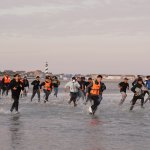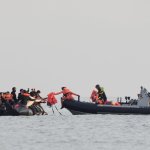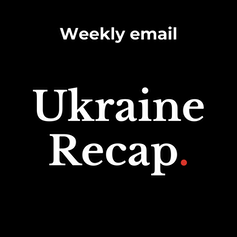As forecast, the focus of hostilities in Ukraine has shifted away from Kyiv and the north towards the south and east of the country where Russia is expected to launch an offensive any day now. In addition to the siege of the port city of Mariupol, where Ukrainian marines are reported to have surrendered in large numbers this week, people in the eastern region of Donbas are bracing for a major attack.
The battle for the Donbas region will be different in character from the urban warfare seen so far in the war in Ukraine. The area has seen fighting on and off since 2014 with more than 13,000 people killed, despite efforts to reach a negotiated settlement. Now the fighting is forecast to be fiercer than ever.
It will be a “knife fight”, writes Frank Ledwidge, an expert in military strategy, conducted around salients, or geographic and strategic “bulges” in which Ukrainian forces risk being caught and cut off. Ledwidge predicts the next phase will be bloody and protracted, more like the manoeuvre battles of the second world war than the fighting that has taken place up until now.
Read more:
Ukraine: the battle for Donbas will be protracted and bloody – military expert
Fighting in the Donbas since 2014 has – on the Russian side at least – involved pro-Moscow separatist militias. Militia fighters – not part of a country’s official armed forces, but often state-funded and trained – are becoming increasingly common in modern warfare. Both sides are using militias in Ukraine to boost their military capacity.
This is our weekly recap of expert analysis of the Ukraine conflict.
The Conversation, a not-for-profit news group, works with a wide range of academics across its global network to produce evidence-based analysis. Get these recaps in your inbox every Thursday. Subscribe here.
Dale Pankhurst, whose research takes in the use of non-government armed groups, is concerned that away from major cities such as Kyiv and Kharkiv, central control of these militias may become more tenuous. He points to human rights abuses already committed in the Donbas region over the past eight years and fears this aspect of the war may intensify.
Read more:
Ukraine war: the key role played by volunteer militias on both sides of the conflict
Nato prepares
Next month, meanwhile, Nato will hold the Defender Europe 22 exercises across eastern Europe and the Baltic States. This is designed to test the US military’s ability to rapidly deploy a large, combat-credible force of soldiers and equipment from the US to Europe.
If this sounds as if it was tailor-made to respond to the situation in Ukraine and the threat of escalation, it isn’t, writes Kenton White, a lecturer in strategic studies and Nato expert. Nato holds regular exercises and these have been planned for some time. The thing to watch, writes White, is whether – and how many – US troops remain in Europe afterwards.
Read more:
Ukraine: Nato exercises a happy coincidence ‘just in case’ of escalation
Nato looks set to become bigger in the coming months. Sweden and Finland are both reportedly discussing how to fast-track applications to join the alliance as a result of the conflict in Ukraine and what they see as a growing threat to security in their region. But Caroline Kennedy-Pipe and Afzal Ashraf believe that this move could add risk to an already perilous security situation in Europe. If Ukraine’s pivot to the west is partly behind Vladimir Putin’s decision to invade Ukraine, they write, the prospect of an ever-larger Nato on Russia’s doorstep could make for a more dangerous situation than ever.
Read more:
Ukraine war: Sweden and Finland eye the Nato option, but it’s a security dilemma for the west
Putin’s Russia
Much has been written about the narrative available to ordinary Russians watching the “military operation” in the state-managed news bulletins or reading about it in the country’s no-longer independent press. Many have little choice but to accept at face value the misinformation coming out of the Kremlin about their military’s conduct of the war – after all, the penalty for even calling the conflict a “war” is harsh.
But to western ears these excuses ring hollow. Few believe the Kremlin’s insistence that the Ukraine military has been shelling its own hospitals and residential neighbourhoods or staging atrocities such as the ones discovered at Bucha and elsewhere over the past fortnight as Russian troops have retreated. The Russian language has a word for such apparently lame excuses: “Vranyo”. As linguist Neil Bermel explains, this is when someone tells a barefaced lie that they don’t expect anyone to believe. As one wag puts it:
You know I’m lying, and I know that you know, and you know that I know that you know, but I go ahead with a straight face, and you nod seriously and take notes.
Read more:
Ukraine war: ‘vranyo’ – Russian for when you lie and everyone knows it, but you don’t care
And, just maybe, Putin and his propagandists are telling an increasing number of Russians what they want to believe. Since 2014, when Russia annexed Crimea, indulging in a blaze of nationalism as it did so, growing numbers of Russians have said they identify more with the Soviet Union than with Russia. Neil Whitehead and Paul Chaisty, both experts in Russian politics and society, have been tracking attitudes towards Russian national identity and have found that this is mainly about cultural nostalgia and a hankering after the old Soviet welfare state, rather than a reflection of a dream about a renewed Soviet empire.
Read more:
Putin’s Russia: people increasingly identify with the Soviet Union – here’s what that means
War crimes
And with the discovery of what appear to be war crimes in areas that the Russian military has been forced to relinquish, as well as a growing body of testimony describing atrocities committed by Russian troops, the clamour for the culprits – and the people who command them – to face justice becomes ever louder. The US president, Joe Biden, has gone as far as to call what has taken place in parts of Ukraine a “genocide”, which is considered to be the most serious crime investigated by the International Criminal Court.
Meanwhile, Ukrainian president, Volodymyr Zelensky – who also refers to what has taken place in his country as genocide, has announced he will set up a “special mechanism of justice in Ukraine” to try war crimes. International legal experts Kathryn Allinson and Lawrence Hill-Cawthorne consider what this special mechanism might look like.
Read more:
Ukraine: Zelensky’s ‘special mechanism’ for prosecuting war crimes explained
Ukraine Recap is available as a weekly email newsletter. Click here to get our recaps directly in your inbox.
![]()











